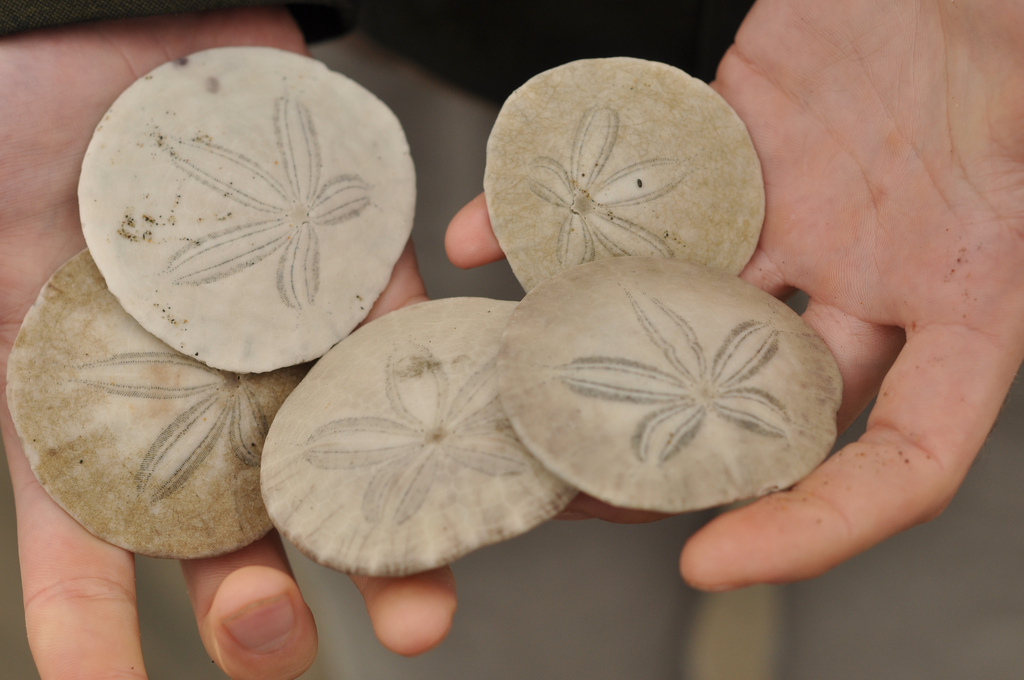By Richard Valasek
I am looking at a 250,000,000 year-old fossilized sand dollar from England I bought on a recent trip to Dallas. What an enduring life form is this elegant little echinoderm. It gives me a sense of security that this was chosen by Arthur as a symbol to represent Ortho-Bionomy. It was Scot O’Shea who pointed out to me a significant difference between this ancient fossil and the pattern of the Ortho-Bionomy sand dollar. The tips of the “petals” are closed in the old one. The modern sand dollar has evolved to the open pattern that so appealed to Arthur.
We find this gap, this not-quite-joining (puka we say in Hawaii) in several of our symbols in Ortho-Bionomy. Arthur insisted on the hyphen in the name “Ortho-Bionomy” to represent this vital gap. He introduced us to the Ortho-Bionomy hand symbol to express the same notion, representing the space we allow between ourselves and our client. This is what some jokingly call the Ortho-Bionomy secret handshake. Phyllecia Rommel calls it hippopotamus kisses. I refer to it as the Ortho-Bionomy spark plug. If there is a space between you and the other there can be no pushing, no coercing. I often have students join together in a circle of “hippopotamus kisses’ and feel the energy of the circle build. The experience is that much more powerful than if we simply held hands. For those of you who may have missed this in your classes the symbol is formed by making circle with your thumb and middle finger, but not quite touching. In a circle of people one hand will be up and the other down and the circles connect like the links in a chain, all without quite touching.
The gap can also be seen to represent the homeopathic principle of Ortho-Bionomy, the notion of less is more, the nothing that we do so skillfully. By being simultaneously connected to the field of interaction and differentiated from the field – linked and not linked – we allow the other (and ourselves) to move naturally to a state of harmony that is self-determined, not externally imposed. We often get asked how it is that we come to have the land dollar as our logo, Some think the spiral patterns of Phase 7 might be more appropriate. Arthur was very reluctant to show these symbols to just anybody and wanted a symbol that somehow suggested the spiral without openly revealing it, The spiral of course is the basis of many forms of nature and Arthur saw the spiral in the sand dollar.Arthur’s son, Harreson Sinclaire has written that the sand dollar logo:

“… is the original image of the first sand dollar that Arthur found on a beach way back in 76′. At the time, the story goes Arthur was looking for an image that represented his new found creation, and had given up on finding one, instead of letting the image find him. He was waking on a beach in California and at the time had never seen or heard of sand dollars, and picked one up, and from there the realization hit him that this was what he was searching (sic) for. The image on all the cards is of that original he first saw, as no two are alike. Arthur considered the star image as representing the image of the human figure, arms and legs outstretched, a pure symbol of opening.
Also like the spiral, the patterns are not closed but open at the ends. He often wondered how a brainless organism could have created such an amazing pattern, as to him it seemed to represent some great universal symbol.”
Arthur also expressed hopes that this symbol of natural the practice of Ortho-Bionomy to be different in many ways from what he started. What he would hope though would be that he would always be able to recognize the work as Ortho-Bionomy. Though there are differences in the pattern of my 250-million-year-old sand dollar and the on€ on that California beach that gave its pattern to Arthur I did not have to ask what it was, I instantly recognized it as a sand dollar. The pattern of the sand dollar, like Ortho-Bionomy is spread open, evolving, allowing the flow of the energy of the universe.
Richard Valasek is an Advanced Instructor of Ortho-Bionomy. Scott O’Shea is a basic Instructor of Ortho-Bionomy and Phyllecia Rommel is an Advanced Instructor of Ortho-Bionomy.
Copyright 2000 Society of Ortho-Bionomy International, Inc.
